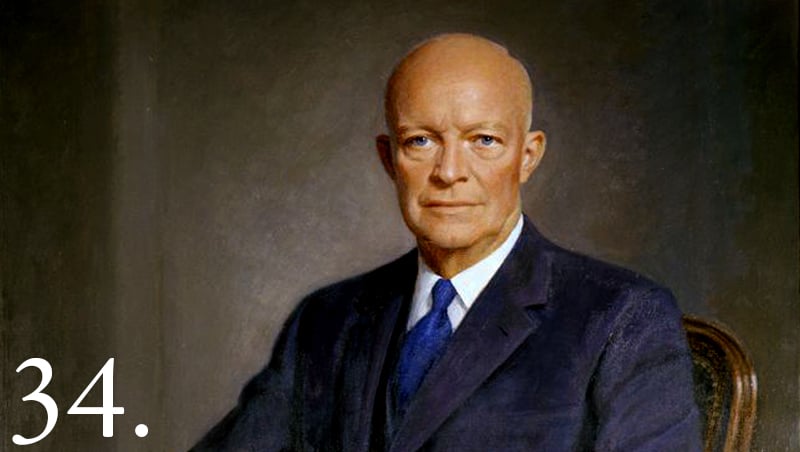
President Eisenhower sat down before television cameras and delivered his farewell speech to the nation some 60 years ago, a speech that became famous for one trope — beware the Military-Industrial Complex.
In this landmark speech, one of the nation’s most revered warriors called for balance in the nation’s affairs: “Good judgment seeks balance and progress; lack of it eventually finds imbalance and frustration.” But what is most remembered is that he also warned the nation of the potential for collusion between portions of the state and the defense industry: “In the councils of government, we must guard against the acquisition of unwarranted influence, whether sought or unsought, by the military-industrial complex. The potential for the disastrous rise of misplaced power exists and will persist.”
Eisenhower had guided America through one of its most perilous transitions from the hot war in Korea to the burgeoning Cold War with the Soviet Union. While there were many times when hostilities could have broken out and advisors did outline options for the use of nuclear weapons, the Eisenhower years were marked by considerable restraint and relative peace.
But Eisenhower’s speech has become known for that one phrase and much has been ascribed to it. But the speech reportedly went through at least 30 edits over almost 18 months and it changed as circumstances did.
Eisenhower was going to call this new animal the “military-industrial-congressional complex,” which most would agree today is a pretty accurate description of the system since it includes all the players. But the outgoing president, apparently worried about political blowback, deleted “congressional,” leaving us with the more sinister –and aurally compelling — term.
But the “complex” that Ike warned us about had yet to be established. Instead, his warning actually helped create the very system he warned against. The answer to Ike’s warning was to reign in the services with centralization and put controls on the industrial base. The 1958 Defense Reorganization Act (passed prior to the speech but caught up in this whole post-Sputnik craziness) was the gateway legislation that paved the way for the Soviet-inspired Planning, Programming, and Budgeting System (PPBS) which governs American defense planning and budgeting to this day. That was followed by the Truth in Negotiations Act in 1962. PPBS (now known as PPBE) helped the Pentagon and Congress do a better job of creating earmarks and TINA led to a unique oversight system that placed barriers in the way of anyone who was not already part of the defense industry. All of this helped drive out experimentation and prototyping and locked in the incumbents.
The reliance on the private sector for weapons during peacetime was a new phenomenon in U.S. history. The historical trend of demobilization, draconian defense budget cuts, and reliance on a limited publicly-run arsenal system led to a military that was always too small and disorganized to support the U.S. when war came. The collapse of global order in the wake of World War II and the rise of the Soviet Union forced U.S. policymakers to recognize the importance of permanently maintaining a large defense budget and a permanent defense industrial base.
That industrial base was to be based on the example of the vital role that the private sector had played in the global war. The role of the automotive manufacturing industry as it supported the army in World War II greatly influenced Eisenhower. As Army chief of staff in a 1946 memo he outlined his view on the role of the private sector in achieving defense innovation: “The armed forces could not have won the war alone. Scientists and businessmen contributed techniques and weapons which enabled us to outwit and overwhelm the enemy.” As president, Ike continued to support government planning to prioritize developments in science and technology, but he also encouraged the private sector to continue to lead in the development and production of weapons.
The result was the rise during the late 1940s and 1950s of a unique peacetime system that had never existed before in the U.S. It was based on the civil-military integration of government-sponsored research with private sector entrepreneur strength. It emphasized multiple sources of innovation and ideas, rapid experimentation and operational prototyping. The result? Creation of new weapon systems capabilities that serve as the backbone of U.S. military strength to this day – nuclear submarines, long-range bombers, jet fighters, nuclear weapons, ballistic missiles and satellites. These revolutionary systems were all developed and deployed in less than five years – something that would completely overwhelm the current system, which now takes three to four times as long to deliver even modest improvements to existing systems.
But Eisenhower’s speech, principally aimed at tamping down the shrill and untrue claims of the famous “missile gap,” perhaps unintentionally stoked the historic fire of populism that distrusted the private sector and feared wartime profiteering. His words would be used to destroy the very innovation system he had helped create and shepherd. Instead, it ensured domination of the type of narrow military-industrial complex he warned against. Understanding how this happened and what Eisenhower’s original intent was are critical to breaking the slow and often ineffective system that creates today’s weapons.
The other factor that may have been behind Eisenhower’s warning was that civil-military integration of the defense industrial base was waning and economic incentives were changing. The defense industry was becoming more specialized as commercial firms that had supported the war effort shifted production back to consumer goods. The remaining group was becoming less diversified with sales and revenues dependent on one customer who would need to be persuaded to continue to spend money on specific programs.
What would become known as the military-industrial complex had indeed worked against Eisenhower by exploiting the narrative of the missile gap. It’s hard for Americans today to imagine how deeply frightened and threatened the country felt when the Soviet Union stunned the world and successfully launched Sputnik. Instead of being transparent and providing the country with sound information, the Air Force manipulated information and worked with military contractors to convince sympathetic members in Congress that they needed more money to close the gap. The Soviet role in taunting the persistent explosion or failure of rocket after American rocket. While often heavy-handed, Soviet propaganda was highly effective after Sputnik because the contrast in performance was so stark. American launches were Kaputniks, Flopniks, and Dudniks and that did nothing to ease the political cost of pursuing a balanced and more cautious developmental approach.
Of course, the Soviet needling helped the US shake off its caution and commit serious resources that led to creation of the Saturn V and the first trip to another planetary body by a human, as well as America vastly surpassing the Soviet Union in the numbers of ICBMs deployed. And the missile gap vanished before Eisenhower departed the White House thanks to intelligence from U-2 flights and the newly developed and highly classified Corona satellite program. But instead of releasing that information, he warned the nation of a new political dynamic that he saw unfolding.
The speech took on a life of its own. Ike’s first mistake in his farewell speech was omitting mention the military-industrial complex’s greatest enabler: the U.S. Congress. By not confronting or addressing congressional patronage, the impact in Congress of the tools that were ultimately used to reign in the military services was and still is largely ignored.
In fact, Eisenhower’s concept of a military-industrial complex gave political cover for Congress and subsequent administrations to enact new legal and regulatory measures that warped the market.
To reign in the services, the centralization tendencies already inherent in the 1958 Defense Reorganization Act paved the way for the PPBS in 1961. Couched in a hypocritical distrust of “excess” profits, Congress passed the Truth in Negotiations Act (TINA) in 1962. The irony of the United States adopting PPBS’ Soviet-style centralized planning methods should not be lost. It also empowered OSD and congressional appropriators with data and procedures to enhance the long-term earmarking and survival of programs over the subsequent decades. TINA led to the creation of a government-unique oversight system that would grow into a much larger and more complex set of barriers to market entry for anyone who was not already in the military industrial complex.
Ultimately, the Kennedy and subsequent administrations attempts to try to control the military industrial complex actually perpetuated it, while destroying an innovation system that had previously fueled the heights of American defense technological achievement. Process and parochialism ultimately drove out new entrants, experimentation, and prototyping and locked in the incumbents who continued to consolidate into the few monopoly providers that exist today.
This, ironically, turned the defense sector into what is in essence a privatized arsenal system ever more dependent on congressional and military service support than Eisenhower had envisioned. Today, we need a different industrial base model to address the inherent inability of these United States to rapidly innovate, both at the Pentagon and – as the Biden Administration will increasingly find out – at the civilian agencies as well.
As the U.S. destroyed the underpinnings of how it innovated in World War II and the immediate post-Cold War period, the U.S. is now faced with – as John McCain would often describe it – a military-industrial-congressional complex that is simply unable or agile enough to effectively compete against China. Ike was right to warn against collusion, but he didn’t target the real problem.
Pass a preemptive CR, deal with inflation and watch the debt limit: 3 tasks for Congress
John Ferrari and Elaine McCusker of AEI argue in this op-ed that Congress needs to act quickly to ensure American national security before getting bogged down in election season.


























